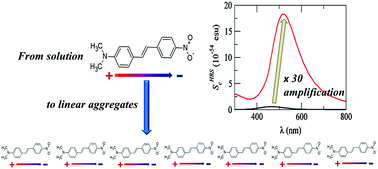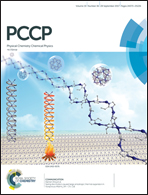Superlinear amplification of the first hyperpolarizability of linear aggregates of DANS molecules†
Abstract
A bottom-up modelling strategy is adopted to discuss the linear and nonlinear optical spectra of a prototypical push–pull dye, 4-dimethylamino-4′-nitrostilbene (DANS), in different environments, from solutions to linear aggregates, fully accounting for the molecular polarity and polarizability. In particular, we demonstrate a large amplification of the first hyperpolarizability of linear aggregates with a superlinear dependence on the aggregate size. Results are discussed with reference to recent experiments for DANS molecules aligned inside single-wall carbon nanotubes, leading to a complete and internally consistent description of the observed spectral properties in terms of ∼7 aligned molecules, reducing by an order of magnitude the size of the aggregate estimated in the hypothesis of linear amplification, as expected for non-interacting molecules. This has important implications for material design: it is possible to obtain a large amplification of the first hyperpolarizability by aligning just a few DANS molecules (or more generally, a few polar dyes showing normal solvatochromism) without the need to grow large ordered systems.



 Please wait while we load your content...
Please wait while we load your content...